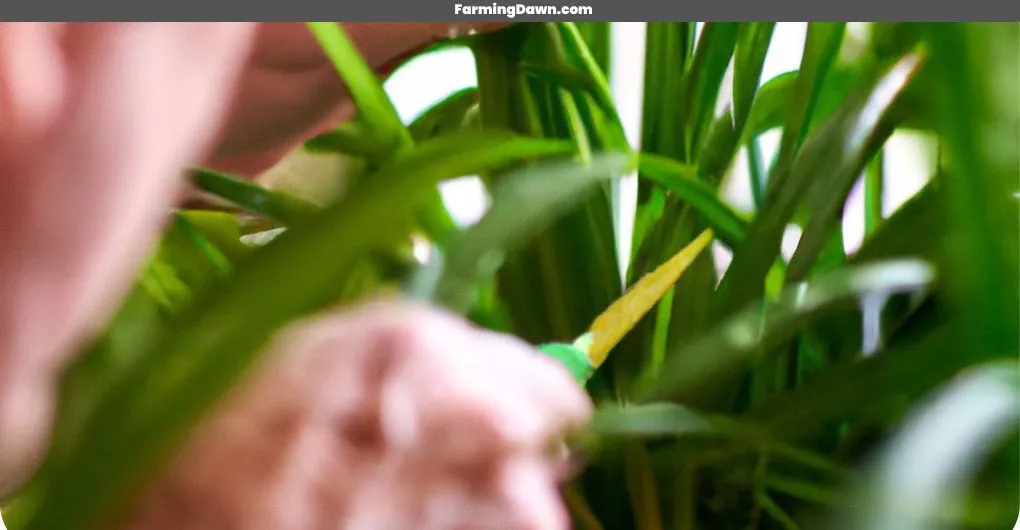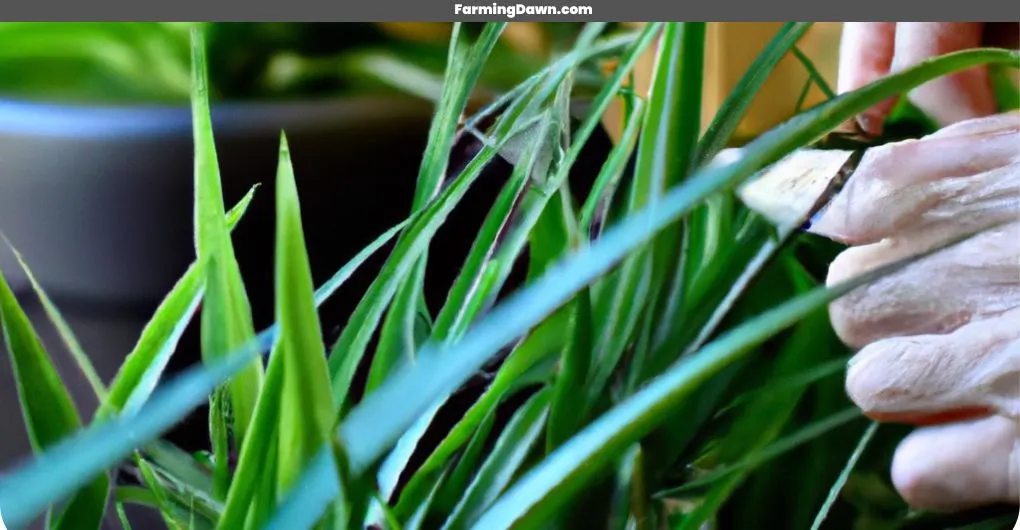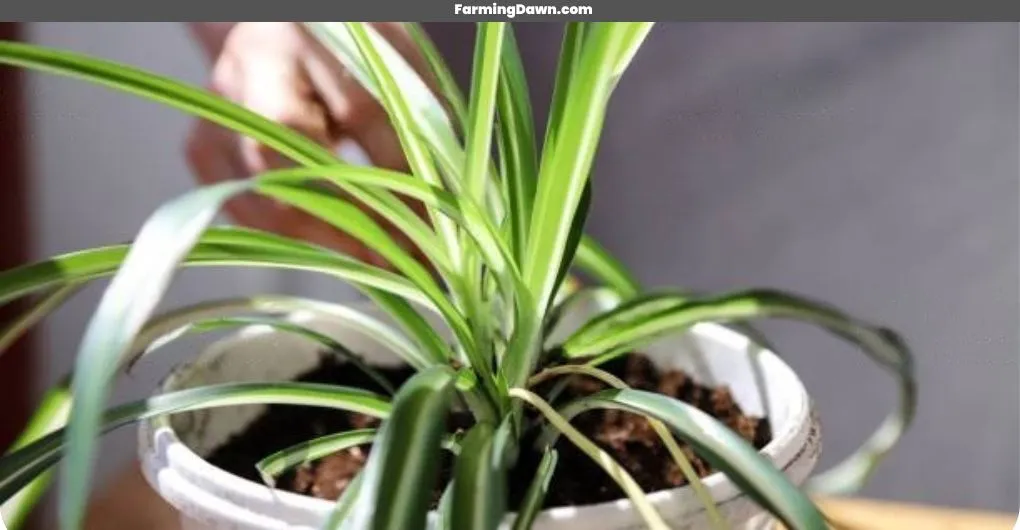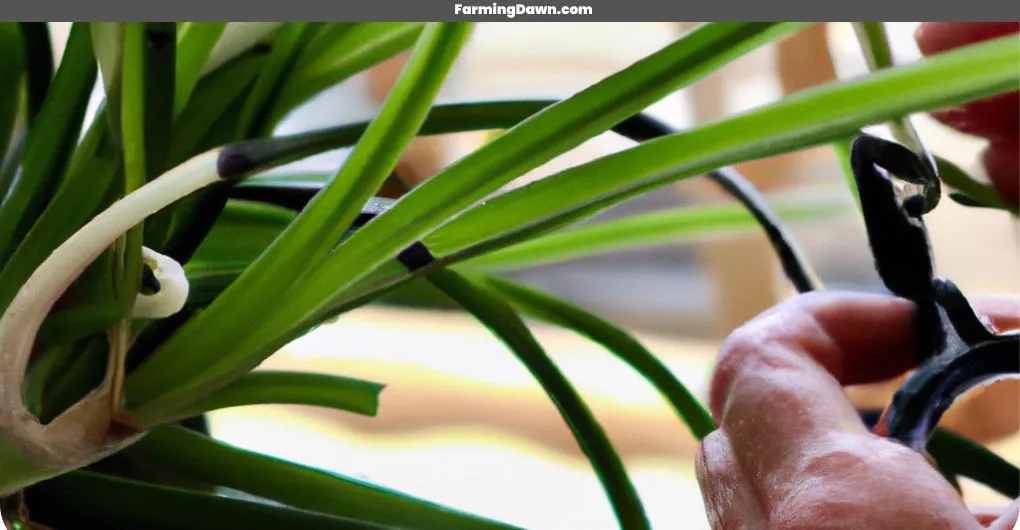Are you looking for the perfect way to make your spider plant bushier? You’ve come to the right place! Here, I’ll show you how to do just that. With a few simple steps and some patience, you can have an even fuller spider plant in no time. Plus, following my tips, it’s almost like joining an exclusive club of green thumbs – and who doesn’t want that? So let’s get started on making your spider plant as luscious as possible!
Why Is My Spider Plant Not Full?
It’s easy to think of our beloved spider plants as a piece of permanent decor. But, like anything else in the garden, they need attention and care from time to time. If your spider plant isn’t full and bushy, it could be because you haven’t given it the trim it needs!
With just a few snips of some garden shears and regular pruning, you can help make your spider plant bushier than ever before. Now that you know what might be causing the stunted growth of your spider plant. Let’s discuss how to make it bushier.
How To Make Spider Plant Bushier?
There are several ways to make your spider plant bushier. From choosing the right pot to planting with friends, you can take small preventive measures to increase the growth of your plant. I have listed below the following steps:
- Choosing the Right Pot
- Regular Watering
- Proper Fertilization
- Pruning and Trimming
- Repotting
- Providing Adequate Light
- Encouraging Root Growth
- Planting with Friends
All these steps have been experimented with me in my own garden and I can tell you I have achieved beautiful results. Now, let’s discuss these points in detail, so you can get a better understanding of the problem and its solution.
Spider plant has spiky leaves. If you would like to see more plants with the same foliage and tropical beauty, consider reading my other post 15 plants with spiky leaves.
Step 1: Choosing The Right Pot
The key to making a spider plant bushier is choosing the right pot. When picking out your pot, you should make sure it’s big enough for the roots of your spider plant and that it has drainage holes at the bottom.
For best results, use an organic potting mix or soil-less mixture combined with some organic fertilizer. This will give your spider plant the nutrients it needs to grow strong and healthy while also helping its branches become fuller and bushier.
When planting your spider plant in the pot, fill it up just below where the leaves begin so that when you water it, it doesn’t spill out over the top. Make sure not to compact the soil too much as this can limit oxygen supply to the roots, which could lead to stunted growth or even the death of your beloved plant!
Step 2: Regular Watering
You can make your spider plant bushier by providing regular watering and keeping the moisture levels up. Using distilled water is a great choice as it won’t contain any traces of minerals that may accumulate in soil or potting mix, which could damage the delicate roots and leaves of your spider plant over time.
Watering needs vary depending on the climate where you live, but generally speaking, most spider plants need to be watered once every week to 10 days during active growth periods.
Be sure to check the top two inches of soil before each watering; if they’re dry, then give them some water! If they’re still damp, don’t overwater – too much liquid will cause root rot and other problems for this tropical beauty.
Step 3: Proper Fertilization
To keep your spider plant looking lush and full, you must provide proper fertilization and humidity levels. Fertilize with a balanced fertilizer every few weeks during the growing season (spring through early fall).
Be careful not to over-fertilize as this can cause root rot in your plant. High humidity is also important for healthy growth; consider placing your potted spider plants on trays filled with wet pebbles or misting them regularly. This will help maintain the high humidity needed for vibrant foliage.
Step 4: Pruning And Trimming
In the same way that proper fertilization helps a spider plant grow, pruning and trimming can help make it bushier. To help your spindly spider become lush and full of life, you’ll want to carefully clip off any spent flower stems or browned leaves from the stem tips.
This will encourage lateral branching and create a fuller, more symmetrical shape for your beloved houseplant.
Of course, when taking scissors to your petite potted friend, be sure not to overdo it; too much pruning may leave your plant with an uneven balance and stunted growth – something no one wants!
Instead, use sharp tools like shears or scissors to only remove dead parts of the plant while also keeping in mind what kind of look you’d like to see in the end: if you desire a bushy spider, then take extra care when removing excess foliage as this will promote new leafy branches.

Step 5: Repotting
Repotting your spider plant is one of the most effective ways to make it bushier. It’s a simple process, and can be done every 1-2 years or so – just pick out a pot that’s slightly larger than its current container and fill it with fresh soil!
Make sure you use a well-draining potting mix; the reason I already discussed above. When repotting, start by gently loosening the roots from the old soil before transferring them into the new pot. Be careful not to damage any of the delicate feeder roots, as these are what provide nourishment for your plant.
Once you’ve potted up your spider plant, give it plenty of water but don’t let it sit in standing water – remember, too much moisture can cause root rot! Afterward, place it somewhere bright and keep an eye on it: if all goes well, you should see some new growth within a few weeks.

Step 6: Providing Adequate Light
Repotting your spider plant is a great way to encourage bushiness and create an environment for growth. After the repotting process, it’s important to provide adequate light in order to foster healthier, fuller plants.
Lighting plays an integral role in encouraging healthy life, so be sure that your newly potted spider plant is positioned near a window or other source of natural light. It should also receive some afternoon sun if possible – but not too much!
Ideally, I would suggest keeping the temperature range between 65-75 degrees Fahrenheit for optimal health. Make sure you have drainage holes at the bottom of your pot as well; this will help ensure no root rot occurs due to overwatering.
Step 7: Encouraging Root Growth
Most gardeners have experienced the joy of seeing a spider plant grow bushier. But it takes more than just time and patience to help your plants reach their full potential. Encouraging root growth is an important part of helping a spider plant become fuller and lusher.
To start, you can also divide up your mature plant into smaller baby plants with slightly browned tips – these will help create fuller foliage when planted separately in appropriate soil conditions.
If you want even quicker results, try using liquid seaweed fertilizer once per month during the growing season for extra nutrients that will encourage healthy new growth in your spider plants.
Step 8: Planting With Friends
Growing your spider plant doesn’t have to be a solitary endeavor. Planting with friends is an excellent way to maximize the growth potential of your bushier, happier plants. Like any good relationship, you can build on one another’s strengths and create something better than either could alone.
During the growing season, invest in multiple mother plants or clones of the same variety for planting together. While some may argue that this type of gardening takes up more space, it actually encourages healthier root systems as well as more vibrant flowers and foliage over time.
By planting with friends, you’re creating a support system for each individual plant to thrive and reach its fullest potential. And when they do bloom? Nothing will compare to the beauty that comes from such mutual encouragement!
Here are some of the best companion plants for spider plants:
- Pothos (Epipremnum aureum)
- Snake Plant (Sansevieria)
- ZZ Plant (Zamioculcas zamiifolia)
- Peace Lily (Spathiphyllum)
- Philodendron
- English Ivy (Hedera helix)
- Boston Fern (Nephrolepis exaltata)
- Chinese Evergreen (Aglaonema)
- Aloe Vera (Aloe barbadensis)
- Rubber Plant (Ficus elastica)
- African Violet (Saintpaulia)
- Golden Pothos (Epipremnum aureum ‘Marble Queen’)
- Spiderwort (Tradescantia zebrina)
- Bromeliads (Bromeliaceae family)
- Money Plant (Pilea peperomioides)
The aesthetics of the spider plant are enhanced by these companion plants, which also require similar maintenance and provide an attractive variety of leaf forms, colors, and textures.
By following all the above-mentioned simple steps, you’ll be on your way to having a lush and bushy spider plant! With some attention to detail, you can provide your beloved houseplants with the resources they need to thrive and reward them with beautiful blooms all year round.
What Causes Spider Plants To Grow Slowly?
I reckon the lack of light and poor soil quality are two of the main reasons why spider plants grow slowly. You see, not getting enough sunlight can stunt the growth of the plant, while poor soil quality can make it harder for the plant to absorb the nutrients it needs.
So, if you want your spider plant to grow bushier, you gotta make sure it’s getting enough sunlight and that the soil is of good quality. Otherwise, it won’t grow as healthy and as fast as it should.

Solution For Lack Of Light
To fix this issue and make your spider plant bushier, place it near an east or west-facing window that gets lots of natural light throughout the day. You can also supplement with artificial lighting such as fluorescent grow lights if needed.
Solution For Poor Soil Quality
To fix this problem, you should consider repotting your spider plant with fresh potting mix and adding a slow-release fertilizer once every season. Then, just sit back and watch as your beloved spider plants start growing again!
Frequently Asked Questions For How To Make Spider Plant Bushier
Do spider plants need to hang?
No, hanging is not necessary for spider plants. They may be grown on shelves, tables, or other surfaces, as well as in hanging baskets. They can flourish in a variety of locations as long as they get enough light and water.
Should I soak my spider plant?
Yes, periodically soaking your spider plant can be helpful. Between waterings, let the plant’s soil somewhat dry up before giving it a good bath until the water runs out of the container. To avoid root rot, avoid overwatering.
Is milk good for spider plants?
No, milk is neither helpful nor required for spider plants. They get their nutrition from the water and soil. Milk may cause bacterial or fungal development, which might injure the roots of the plant. For the best health of your spider plant, provide adequate watering and fertilizing.
Does coffee help spider plants?
Although certain plants can benefit from the use of diluted coffee as a liquid fertilizer, it is often not advised for spider plants. Coffee can make the soil more acidic, which might be harmful. For spider plants, it is advisable to stick with recommended fertilizers and watering methods.
How big can a spider plant get?
Spider plants can grow up to 2 feet (60 cm) in height and have a spread of up to 2-3 feet (60-90 cm) when grown in a hanging basket. However, depending on the growth environment, maintenance requirements, and particular spider plant species, their size may change.
Should I mist my spider plant babies?
Misting spider plant babies can provide them with some humidity, which they appreciate. However, if the room’s general humidity level is enough, it is not required. Focus more on providing them with appropriate hydration and covert lighting.
When should I repot my spider plant?
Repotting spider plants is often beneficial every one to two years or when they develop root-boundness. Indications that it’s time to repot include roots poking through drainage holes, overcrowding, or a plant that stops growing despite regular care.
How long do spider plants live?
Spider plants have a long lifespan. They may live anywhere between 20. Regular care, such as appropriate watering, lighting, and even repotting, can help the plant live longer.
How To Make Spider Plant Bushier? -Conclusion
It’s a real treat to watch your spider plant thrive and fill out! With the right conditions, care, and companionship, you can have a lush bush of foliage in no time. As long as you keep up with regular waterings, fertilization, and pruning when needed, then there’s nothing stopping your spider plant from flourishing.
It’s like watching an old friend grow into something beautiful; it just takes some effort on our part – but that’s what gardening is all about! So don’t be intimidated by this process; simply take it one step at a time, and soon enough your spider plants will show off their full potential.
Taking plant of your spider is just first step. If you want more tips and tricks for the better care of your other plants. Read my other articles to learn more:





